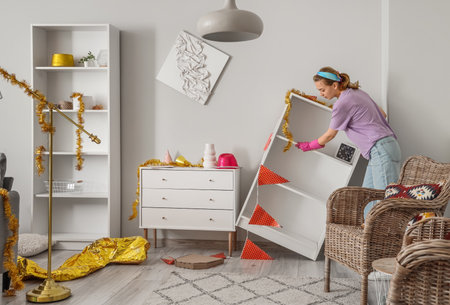Introduction to Clutter in British Homes
Clutter is a word that resonates deeply within many British households, conjuring images of overstuffed cupboards, neglected attics, and those “bits and bobs” that seem to collect on every available surface. In the context of daily life across the UK, clutter goes beyond mere untidiness—it is often woven into the very fabric of our living spaces. Whether it’s inherited china tucked away for “best,” stacks of post by the front door, or sentimental school reports kept from decades past, clutter can be both comforting and overwhelming. British homes, with their unique blend of period features and compact layouts, frequently become repositories for cherished memories as well as everyday necessities. Understanding what constitutes clutter in a typical British setting means looking at the way we balance tradition with modern living, sentimentality with functionality, and how these choices shape our home environments. This exploration sets the stage for a deeper look at how clutter impacts our wellbeing and why it remains such a persistent part of British domestic life.
2. The British Relationship with ‘Stuff’
When we explore the psychological impact of clutter in British homes, it’s essential to first consider the unique cultural relationship Britons have with their possessions. For many, the home is not just a space to live, but a tapestry of memories woven together by objects, heirlooms, and everyday items collected over generations. This attachment is rooted in both tradition and practicality, shaping how clutter forms and persists in British households.
Cultural Attitudes Toward Belongings
The British approach to belongings can be summed up by the phrase “just in case.” Whether it’s a drawer full of old keys or a cupboard stacked with mismatched crockery, many people hold on to things for potential future use. This habit often stems from wartime thriftiness passed down through families, where waste was frowned upon and resourcefulness was prized. Even today, this attitude influences how clutter accumulates and why letting go can feel uncomfortable or even irresponsible.
Inherited Items and Emotional Weight
Inheritance plays a significant role in British homes. From grandmother’s teacups to grandfather’s armchair, inherited items are more than just objects—they represent family history, nostalgia, and continuity. Parting with these belongings can feel like severing a link to loved ones or disregarding family values. This emotional weight makes decluttering an especially sensitive task.
Tradition vs. Practicality: Why We Hold On
| Reason for Holding On | Typical Example | Emotional Impact |
|---|---|---|
| Sentimentality | Old photographs, children’s artwork | Nostalgia, comfort |
| Practicality (‘just in case’) | Extra cables, unused kitchen gadgets | Anxiety about waste, security |
| Heritage/Inheritance | Family china, antique furniture | Pride, responsibility, obligation |
| Cultural Norms | Bookshelves full of novels, knick-knacks from holidays | Status, belonging to tradition |
This blend of sentimentality and pragmatism means that clutter in British homes often carries deep-rooted meaning. Understanding these motivations is crucial when addressing wellbeing issues related to household clutter—simply getting rid of things may not be as straightforward as it seems.

3. How Clutter Influences Mental Wellbeing
Living among clutter can have a profound psychological impact, often underestimated in the daily rhythm of British home life. The effects go beyond simply feeling untidy; clutter can subtly erode our sense of wellbeing and influence how we experience our living spaces. For many across the UK, homes are meant to be sanctuaries—a place to retreat from the bustle of everyday demands. Yet, when possessions accumulate, even cherished mementoes and practical items can become overwhelming.
Clutter introduces a sense of chaos that disrupts mental clarity. The constant visual reminder of tasks left unfinished or things needing attention can trigger feelings of stress and anxiety. Studies have shown that when our environment feels out of control, our minds often mirror this state. British homeowners may find themselves irritable or unable to relax in rooms filled with piles of magazines, overflowing wardrobes, or kitchen counters stacked with unused gadgets.
The overwhelm caused by clutter isn’t just psychological; it has tangible effects on daily routines. Searching for keys before heading out or struggling to find space to make a cup of tea becomes a source of low-level tension that adds up over time. The traditional British value placed on ‘a tidy home is a tidy mind’ holds true, as orderliness supports a feeling of accomplishment and peace.
Moreover, the sense of embarrassment or shame some feel about inviting friends or family into a cluttered home can lead to social withdrawal—compounding feelings of isolation. The pressure to keep up appearances, especially in tight-knit communities or among neighbours, may further exacerbate these emotions. In essence, clutter doesn’t just fill physical space; it occupies mental space too.
Understanding these psychological effects is key to recognising why clearing clutter isn’t merely about aesthetics but also about nurturing emotional health. By acknowledging how stress, overwhelm, and chaos stem from our environments, British homeowners can begin to reclaim their homes—and their sense of calm—one drawer at a time.
4. Clutter Hotspots: Homes from London Flats to Cotswold Cottages
In the UK, the character of our homes is shaped by both history and geography, which means clutter finds its own special hiding spots depending on where we live. Whether it’s a compact London flat or a rambling Cotswold cottage, every home has its unique clutter challenges—and these can have a real impact on our sense of wellbeing.
Urban Living: The London Flat
Space is at a premium in city flats, particularly in London where every square foot counts. Here, clutter often accumulates in entryways, under beds, and on any available surfaces. Limited storage means even everyday items like coats, shoes, or paperwork can easily spill over into living areas, making the space feel cramped and overwhelming. For many Londoners, this daily squeeze can subtly heighten stress levels and make it harder to truly relax at home.
Suburban Homes: The Semi-Detached and Terrace
In suburban settings—think classic semis or terrace houses—clutter gravitates towards utility rooms, lofts, and garages. These spaces become dumping grounds for seasonal gear, children’s toys, or those ‘just-in-case’ items that rarely see daylight. While there’s more room to stash things away compared to city flats, hidden clutter can still weigh heavily on the mind, leading to a nagging sense of disorganisation beneath the surface calm.
Rural Retreats: Cotswold Cottages and Beyond
Country cottages often come with charming nooks and crannies—perfect for storing wellies and gardening tools—but also prime spots for clutter to take root. Mudrooms fill up with boots and coats after countryside walks; outbuildings house forgotten projects and inherited furniture. In these homes, clutter can accumulate almost unnoticed until it suddenly feels overwhelming, impacting that sought-after sense of rural tranquillity.
Where Does Clutter Build Up?
| Home Type | Common Clutter Hotspots |
|---|---|
| London Flat | Entryways, under beds, kitchen counters |
| Semi-Detached/Terrace | Lofts, garages, utility rooms |
| Cotswold Cottage | Mudrooms, sheds/outbuildings, hallways |
The Emotional Toll of Hidden Messes
No matter the postcode or property type, cluttered spaces quietly undermine our peace of mind. Recognising your home’s specific hotspots is the first step towards reclaiming control—and creating an environment that truly supports your wellbeing.
5. Barriers to Decluttering in the British Context
Clearing clutter from our homes sounds simple on paper, but for many Britons, it’s far more complicated than just boxing up old possessions. There are unique barriers to decluttering that stem from both cultural values and practical realities of life in the UK.
Sentimental Value: The Emotional Weight of History
British homes often hold generations’ worth of heirlooms, keepsakes, and inherited items. These objects aren’t just things—they’re tangible connections to family history and personal memories. Letting go of a grandmother’s teacups or a child’s school artwork can feel like erasing part of one’s identity. This deep-rooted sentimentality is woven into the British psyche, making it emotionally challenging to clear out even seemingly insignificant bits and bobs.
Limited Space: Making Every Inch Count
The reality of British housing—especially in cities like London, Manchester, or Edinburgh—is that space is often at a premium. Many people live in terraced houses or flats with limited storage. As a result, items accumulate in every available nook and cranny, from under-stair cupboards to loft spaces. The lack of space makes it difficult to sort through belongings systematically, sometimes forcing people to simply shift things around rather than make real progress.
Environmental Concerns: Mindful Disposal Matters
In recent years, there has been growing awareness around sustainability and waste reduction in the UK. Many residents feel a sense of responsibility not to simply throw away unwanted possessions. Deciding how to dispose of items responsibly—whether through charity shops, recycling centres, or online community groups—can add another layer of complexity and guilt to the decluttering process. For some, this ethical dilemma becomes a reason to delay clearing out altogether.
The Perfect Storm for Procrastination
When you combine emotional attachments, tight living quarters, and environmental mindfulness, it’s easy to see why so many British households struggle with clutter. Each barrier feeds into the next, creating a cycle that can be tough to break without conscious effort and support.
6. Steps Towards a Tidier, Calmer Home
Decluttering the British Way: Practical Strategies
Clearing clutter in British homes is as much about honouring tradition as it is about creating a peaceful environment. Start by embracing the classic “one in, one out” rule—a staple of British frugality—where every new item that enters your home replaces an old one. This simple practice keeps possessions manageable and spaces open.
Room-by-Room Approach
Tackle clutter systematically by addressing one room at a time. Begin with high-traffic areas like the hallway or sitting room, which often accumulate shoes, coats, and post. Use baskets or traditional woven hampers to contain daily essentials, giving a nod to rustic British charm while keeping things tidy.
Make Use of Local Resources
Don’t let unwanted items gather dust. Take advantage of local charity shops—a cornerstone of British communities—by donating books, clothing, and household goods. This not only clears space but also supports local causes. Community “jumble sales” or car boot sales are another excellent way to rehome belongings and connect with neighbours.
Incorporate Heritage Storage Solutions
Draw inspiration from period homes by using built-in cupboards, under-stair storage, or classic sideboards to stow away bits and bobs. These timeless solutions help maintain order without sacrificing style. Open shelving works well for displaying cherished items while keeping surfaces uncluttered.
Create Calm Through Rituals
British culture prizes routine and ritual. Set aside ten minutes each evening for a quick tidy-up—perhaps accompanied by a cup of tea—to restore order before bed. This small habit can have a profound impact on daily wellbeing and sleep quality.
Connect With Nature
Breathe new life into your home by inviting nature indoors. Fresh flowers from the local market or potted herbs on the windowsill not only brighten spaces but also encourage regular clearing and rearranging, helping you stay mindful of what you truly value.
Cultivating Lasting Wellbeing
Ultimately, reducing clutter is less about perfection and more about creating a sanctuary that reflects your values and brings peace of mind. By drawing on British traditions—resourcefulness, community spirit, and appreciation for heritage—you can foster a calmer home and a happier headspace.


